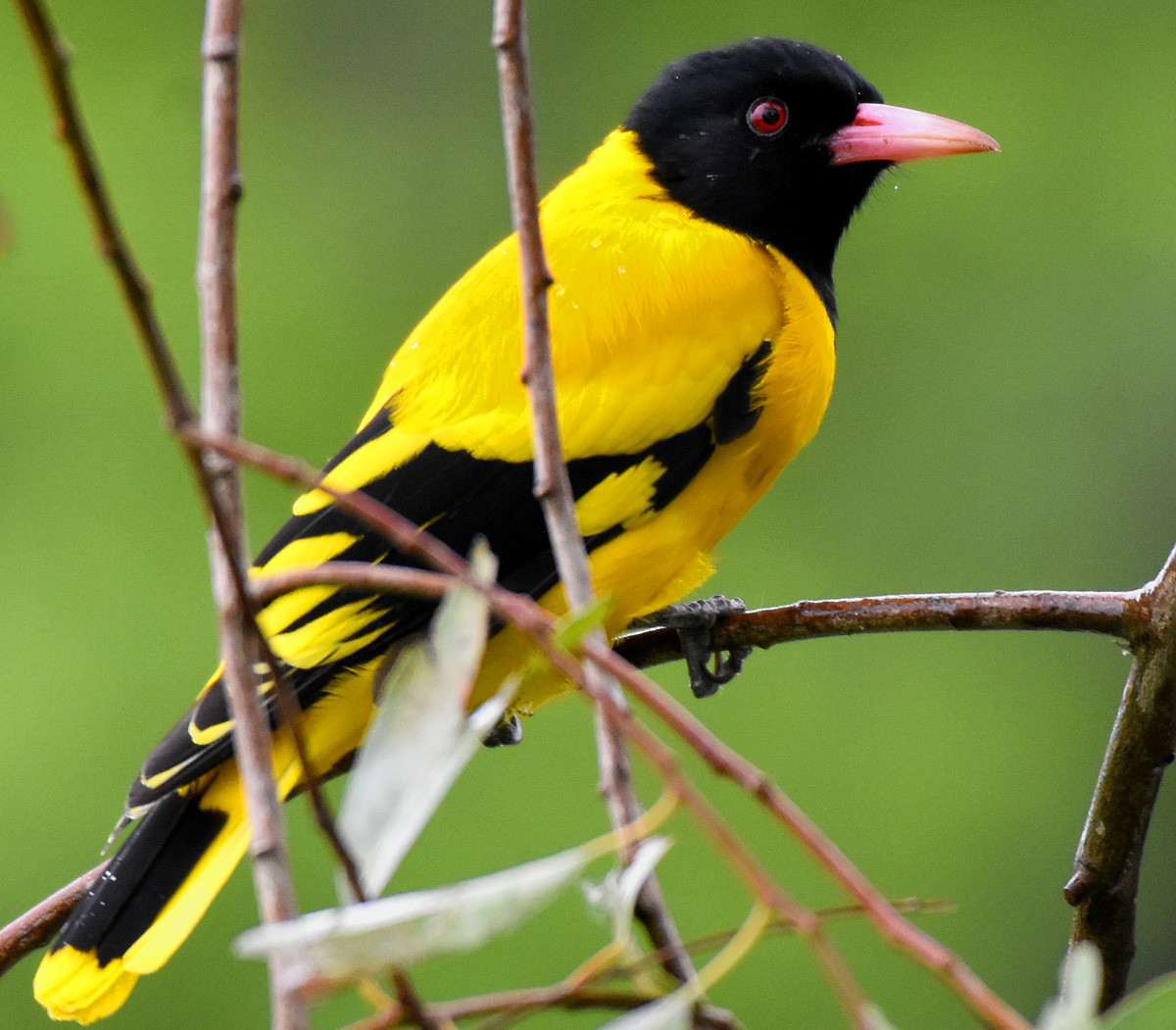A charming bird of Champakdi and a sad saga of shrinking biodiversity
The Black-hooded Oriole, commonly found in our villages and featured in the book "100 Birds to See Before You Die," is a striking sight to behold especially in our diminishing natural habitats

We heard a short, fluty bird-song "pupilio pupilio" as we entered Champakdi, a quiet village of Munshiganj. We knew that the song was of a Black-hooded Oriole, one of the most beautiful birds of the world, even if fairly common in the villages of Bangladesh.
Two authors, David Chandler and Dominic Cousens, recently raised our Black-hooded Oriole to a luminary status by featuring it in their book titled "100 Birds to See Before You Die." They chose only a hundred out of the 11,000 species of birds of the world, and one of our birds made that elite list!
The Black-hooded Oriole, however, is no elite in Bangladesh for its being so commonplace. But every time it crosses our path, we cannot help looking at it spellbound. Its black head and wings put such an accent on its golden body! And its indescribable reddish bill is so out of the world!
Golden yellow, certainly, is the overriding colour of the Oriole. The very name 'oriole' has come from the Latin 'aureolus', which means 'golden.' Its popular Bangla name 'Holdey Pakhi' simply means yellow bird. But the yellow bird would not be so striking, were it all-yellow and had no black feathers.
In his youth, the bird besotted poet Ted Hughes had seen the all-yellow Eurasian Golden Orioles migrating to the English countryside every summer. In a poem, he likened the migrant Oriole with his passing moments of happiness:

Happiness
Appeared—momentary,
Peered in at your window
Like a wild migrant, an oriole...
To the poet, the fleeting moments of happiness were like the Oriole or some other birds at the window that was, as he wrote: "gone before we could identify it." But, thankfully, the singing orioles of Champakdi village stayed long and were not gone before we had seen, identified and photographed all.
The Black-hooded Oriole is probably most abundant in Bangladesh, although it is found in a dozen countries of the Orient. Carl Linnaeus, the legendary creator of scientific nomenclature of living organisms, formally described it in 1758 with an illustration of the bird by George Edwards from Bengal.

Interestingly, the great Linnaeus labelled that bird of Bengal an 'American bird'. He was confused by the illustrations of a similar-looking bird done in Jamaica. Quite a few birds of the American Blackbird family looked superficially like our Oriole and were named 'Oriole' by the English settlers centuries ago.
The error of Linnaeus was corrected later, and Bengal was recognised as the 'place' from where Black-hooded Oriole was first collected. In scientific jargon, such a 'place' is called the 'type location.' With several beautiful Orioles around us at Champakdi, we felt that we were indeed in the correct location.
To be fair to Linnaeus, we must note that 31 species of the American Blackbird family bearing the vernacular name 'Oriole' look quite a bit like many of the 31 species of birds of our Oriole family carrying the same vernacular name 'Oriole.'
Of the American Blackbirds, the most interesting is the bird that lives in Texas and Mexico and is named Audubon's Oriole. With a black hood and yellow body, it looks uncannily like our Black-hooded Oriole, although they belong to very different families and live on two opposite sides of the world.
We have to admit that the Americans are captivated by their Orioles much more than ours. Five cities in the five states of the US are named Orioles, and a major league baseball team is named Baltimore Orioles. But, unfortunately, we are yet to name anything after the Oriole in our parts of the world.

To distinguish between the American Orioles and the Orioles of our parts of the world, we call ours the Old World Orioles. That should be fine with our Orioles so long as 'old' does not mean dated, decrepit and decaying.
We saw several agile Black-hooded Orioles in the tangle of trees and straggly bamboo, along with a web of canals in Champakdi village. We found four splendid adults in dazzling colours and one lacklustre juvenile. The juvenile looked dull with a full yellow body because its head and wings were not black enough to create the proper contrast to bring out the yellow.
Apart from the sprightly Orioles, we sadly missed many other exciting birds we usually found in our previous visits to Champakdi village. This time we missed the hitherto common birds of Champakdi like the coucals, the owls, the shrikes and the cuckoo-shrikes.
We were visiting the Champakdi village after two years of pandemic-driven isolation. We noticed that the green areas of the village had diminished noticeably, and more than a few new clusters of glittery tin-houses and chicken farms have cropped up along the canals and the swamps.

While we were pleased with the five jolly Orioles of Champakdi village, we regretted the palpable absence of a great variety of birds we found there before. What distinguished that village to us was not the great number of a few species of birds but a great diversity of them.
We may be happy to die after sighting the hundred top birds of the world, but we cannot live with only a hundred species of birds! Nature cannot do with only a hundred species of birds; it needs many more to control insects, pollinate flowers and disperse seeds. That is why it has created no fewer than 11,000 species of birds.



 Keep updated, follow The Business Standard's Google news channel
Keep updated, follow The Business Standard's Google news channel
















